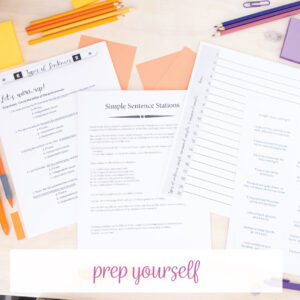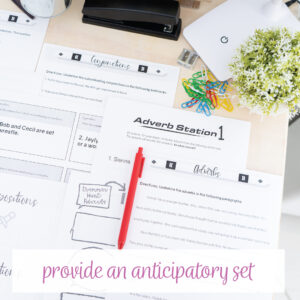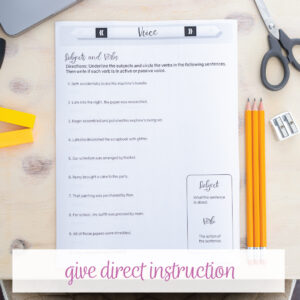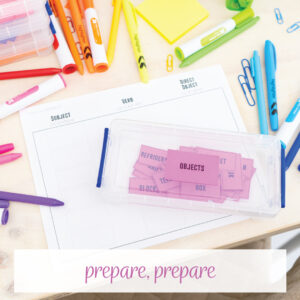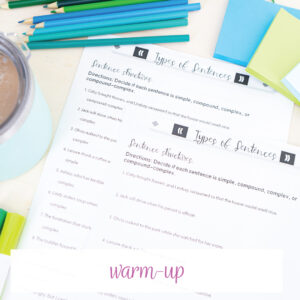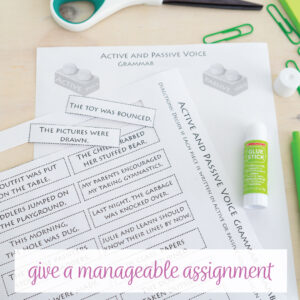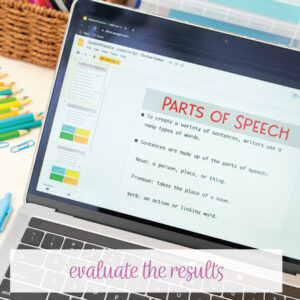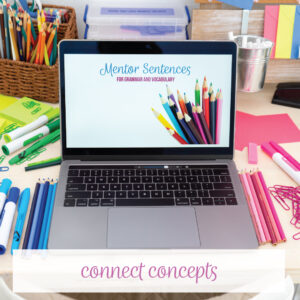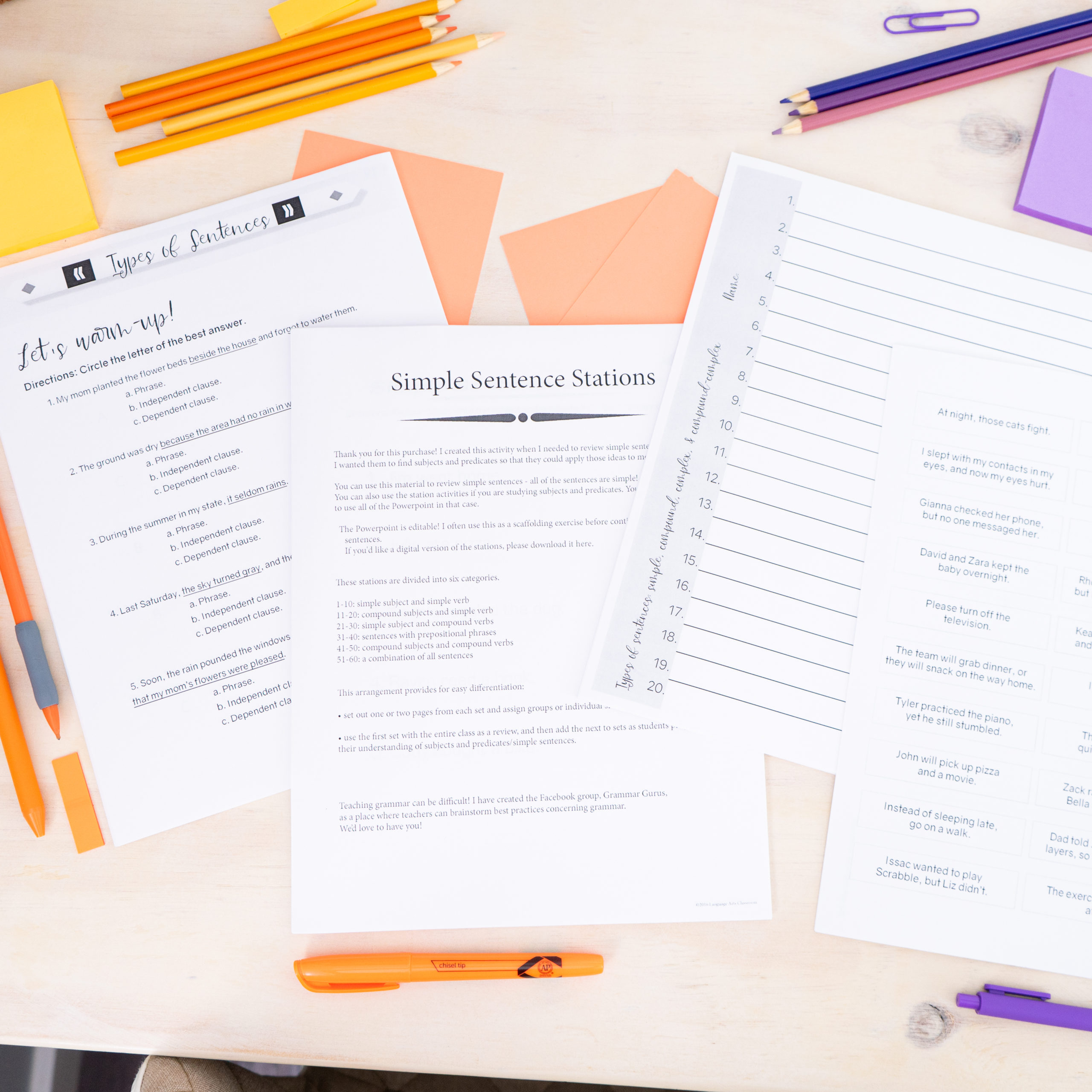How to Build a Grammar Lesson: This post aims to help you from start to finish with sequencing grammar.
My first book, The English Grammar Workbook, was published in 2018. While writing it, I figured that teachers would have questions about the sequencing grammar: How do I make lessons exciting? What alternatives to traditional exercises can I use in my classroom? How do I as a teacher draw a better connection to reading and writing? Are grammar worksheets the devil?
Those were the questions I expected. But those weren’t the questions I got. Overall, the No. 1 question from teachers was, “How do I build a grammar lesson plan?”
This makes sense. I’ve written extensively about how grammar has recently returned to classrooms—and how this leaves teachers in an unfair position. When I began teaching a dozen years ago, I sat (frightened and very unsure) with my students and muddled through grammar lessons. I made errors and failed. I left work crying. I wanted to quit. I felt success in our areas of my classroom, but I did not with grammar. No wonder so many teachers don’t want to teach grammar!
Now, I confidently teach grammar and even enjoy it. I sprinkle fun grammar activities throughout my curriculum, naturally. I want to share these ideas with you, so you can successfully implement grammar and positively impact your students. In this post, I aim to model my thinking as a I write a grammar lesson plan.
What are the key components of a successful grammar lesson?
The key components of a successful grammar lesson include clear learning objectives, engaging activities to practice grammar rules, relevant examples and explanations, interactive exercises to reinforce learning, and a variety of assessment tools to measure student understanding.
Grammar teaching. . . can be intense. When I was working with a team of linguists and editors from my book, I knew that I had to share what I learned about grammar instruction, especially how other countries teach grammar. I want every English teacher to know what I learned so that each ELA teacher can confidently teach grammar and build a grammar lesson of which he or she is proud.
These are my steps to sequencing grammar instruction.
1. Start by prepping yourself.
Acknowledge what you know and embrace what you don’t know. Don’t get down on yourself about the “best” way to build a grammar lesson. The English language is vast, and often, we teachers are not trained to teach grammar, so information gaps happen. How to start teaching grammar? Sequencing grammar? Research your topic.
Before you teach a story, you likely look at the standards and consider vocabulary, the author, and time period. You probably read the story a few times and take notes. Then, you might watch a version of the movie and prepare to show your class clips. You fill the book with sticky notes and take notes in the margins.
Grammar preparation is the same!
Go through similar motions with a grammar lesson plan:
- Use the answer key to practice the concept.
- Research the idea and read about teaching it.
- Anticipate where students might struggle.
For instance, when I teach sentence structure, I can anticipate that students will need to review relative pronouns and subordinating conjunctions. I might scaffold that into the plan. My grammar lesson plans almost always contain scaffolding. Similar to how I arrange any any other lesson in my classroom, I find sequencing grammar in similar ways helps. Use the same activities with grammar that your students already enjoy!
Next, videos are ample on YouTube! Look for trusted sources, like college professors or the dictionary. You might even find some that are on-level to show students. Find resources that connect grammar to a bigger picture.
Finally, if you are unsure of where to start, it is appropriate to give a pretest. Look at the results, and consider the support your learners need. Once you’ve decided on what to teach and reviewed it, you’re ready to design your grammar lesson plans.
2. Provide an anticipatory set.
Grammar lesson plans are not that different from other ELA lesson plans. Grab a good cup of coffee and work at your own pace. To start. . .
Activate prior knowledge and, hopefully, provide a transition. Normal anticipatory sets that you use with other lessons will help you build a grammar lesson. Videos about parallelism, verb voice, verb moods, and other language concepts exist. Not only will you be engaging students with a preview of the concept, but you will also be relating to students who might want to be linguists or translators.
Videos work well, and you can check out my suggestions.
Other possible introductions for a grammar lesson.
- Ask students to label examples of the concept. I once saw an English teacher hand students a “Hello, My Name Is” sticky tag as they entered the class. She instructed them to identify a real noun in the classroom and adhere the name tag to it (e.g., board, chair, desk, person). I often use sticky notes and then when we cover adjectives, we use a different colored sticky note to describe the labeled nouns.
- Brainstorm a list of concepts. If you are teaching simple sentences, ask students to list two simple sentences on a note card. Review the simple sentences, and then start combining them into compound sentences. Using the note cards in an anonymous way is fun because the compound sentences are goofy when you put them together: Mom made dinner, for she loves the dog. (You get the idea. Students love to create funny sentences, and they remember the concepts when they have fun.)
- Show students they already write using the concept. Ask students to pull a sentence from a piece of writing or invent one for them.
Just as you would with a literature lesson, give a transition: You do understand nouns! A pronoun takes the place of a noun. Today, we will talk about pronouns. The more you teach grammar, the easier sequencing grammar will become.
(If you need a grammar lesson plan sample or pacing guide, download several free ones in my library.)
Once you see that designing a grammar lesson requires the same concepts as a literature or writing lesson, you’ll have more confidence.
3. Give direct instruction—but connect to concepts.
Many grammar lesson plans include direct instruction in some capacity. Not every part of a grammar lesson should be direct instruction; however, I know that many teachers fear that a grammar lesson will only be direct instruction. Don’t allow that fear to stop direct instruction. Our grammar lessons will move beyond the grammar worksheet and can include grammar games. Here are pieces that will work; consider these part of a grammar lesson plan sample.
English Samples
Create a presentation with facts, lists, and examples. Be sure to include the why behind learning such material. For example:
Q: Why do we need to learn types of pronouns?
A: When writing and then proofreading, writers must anticipate that readers will need clear pronouns and antecedents.
Q: Why are the differences between active and passive voice important?
A: Speakers and writers sometimes use passive voice to manipulate situations or evade responsibility. Audience members and readers should know how to detect the differences.
Students need concrete definitions in order to internalize concepts. So, ask students to write the definitions and commit them to memory. Then, show the concepts used in real sentences.
Chunk Information with Domain-Specific Vocabulary
The direct instruction part of a grammar lesson plan is the perfect time chunk information. If we return to the sentence structure example, you might chunk your grammar lesson in several ways, totally dependent upon where your students are in their understanding:
- Subjects and verbs.
- Types of conjunctions.
- Types of clauses.
- Simple and compound sentences.
Chunk your lessons at the point your students need. Some classes fumble with complex sentences, but they are fine with simple and compound. Chunk simple sentences and compound sentences, and then work on subordinating conjunctions followed by relative pronouns. Add subjects and verbs, and then work on dependent clauses. Add logical chunks as you are sequencing grammar.
For another example, think of punctuation lessons. Older students typically understand commas, periods, and question marks. They might be less familiar with semicolons, dashes, and ellipses. Review and praise what students know, and then build off that prior knowledge. Dashes (for instance) indicate a pause, much like a comma; however, a dash is less formal. Often, dashes are used with dialogue.
As you continue to shape your grammar lessons, you’ll continue to find talking points, examples of prior knowledge, and methods of chunking.
And, if you’re still worried about providing direct instruction in grammar lesson plans, don’t be. You’re setting a great foundation for your students.
4. Prepare, Prepare: Build up the examples you’ll show.
When you first question how to start teaching grammar, you might feel overwhelmed. During the first year or so you deliver grammar lessons, giving examples for grammar may seem nerve-racking. Come prepared with examples. Write them on a note card or put them on a presentation. Then, start adding to the examples slowly.
Have an entire example ready, but leave out the subjects or proper nouns. Ask students to add to them. Look:
___ and ___ love ice cream.
This sentence formation is: compound subject, verb, direct object. Ask students to provide two subjects (two names) to teach nouns or subjects.
As you become more comfortable with student-generated lessons, you can allow students to add more parts of the sentence without planning. Eventually, your grammar lesson plan sample will be filled in with strong and funny examples.
5. Warm-up.
After you show examples and define terms, let students practice. Provide students with 10 problems to practice with partners. Circulate the classroom so you can identify misconceptions and reiterate parts of the lesson.
From this basic student practice, you might need to redefine terms. You might need to stop and create an anchor chart with lists or important details. Sometimes, students are not ready for an assignment, and I don’t give them one. If I think that students will be frustrated when they work on the concept, I end at this basic practice. I’ll return to step one and try again the next day with a different approach. I return to my grammar lesson plans and modify.
If students overall seem ready to continue, provide an assignment. Remember, sequencing grammar instruction should follow the premise of other lessons too.
6. Give students a manageable assignment.
Similar to literature or writing activities, when you build a grammar lesson, start small. Ask your students to complete an assignment. Twenty sentences or multiple paragraphs is not necessary; give students five or 10 sentences. Exit tickets work well too. If you are looking for an activity that is not a grammar worksheet, you can download my grammar activity sheet for free.
The purpose of this first grammar assignment after new instruction is not to fret over perfect scores. Evaluate where your students are: What do they understand? What needs reviewed?
Decide if you want to record the grades or not. The first time with a new concept, I typically do not record the grades. I use the assignment as a gauge for the next day’s lesson. Recording the grade is a teacher’s choice, but if students regularly fail grammar, they will resent the lessons.
7. Evaluate the results; evaluate sequencing.
First, don’t expect perfection the first time you build a grammar lesson. Unless you work at a school where teaching grammar is the norm, you might not have high results the first few times sequencing grammar lessons. Learning grammar is a complex way of thinking, and while that is great for students’ brains, it requires that instructors be patient with their students.
As you evaluate, consider the process used to convey the material and the assessment. Different students learn in various ways and while some students enjoy videos, others might learn more from graphic organizers. Just as we teachers reassess when a literature or writing lesson doesn’t produce the results we’d like, we should do the same with grammar lessons.
Be patient with yourself as well. If the results of your first few grammar lessons are poor, provide other ways to study the material. The next class period, return the lessons and cover the concepts. You might reteach a few areas, and you might ask students to create anchor charts. You might ask students to write using the concept, and you might ask them to find samples of the grammar concept in their reading.
Those first times as you work how to start teaching grammar, give yourself freedom to change and grow. Evaluate how you sequenced the material, and modify if necessary.
8. Connect the concept the rest of class.
For me, the key component to build a grammar lesson plan that succeeds is to connect grammar to other parts of class.
If English teachers are not intentional in using domain-specific language and connecting grammar to literature, speeches, and informational texts, students won’t find value in learning grammar. They will continue to see grammar as “something wrong” with their writing. And? That’s sad.
Understanding and knowing grammar empowers readers and writers. We can connect grammar to the rest of class by looking an author’s sentence structure or unique verb use. Also, we can question why a reporter used passive voice. Additionally, we can decide if a mystery writer is specifically using vague pronouns to build suspense.
Of course, grammar errors do hinder communication, especially in writing. We should help students become expert communicators. I’m not one to squabble over splitting infinitives or ending a sentence in a preposition. Instead, I strive to show students that our grammar lessons help us understand the rest of our class in unique ways.
9.Become a grammar nerd and explore nouns, manipulatives, paragraphs, and more
Once you feel confident in meeting language standards and using grammatical concepts with students, add fun and memorable pieces to your repertoire.
A low-pressure activity it to write a group paragraph. Start students off with a sentence, and then pass the paper around the room. Students will write a story where you can identify nouns, sentence structure, verb use, and more.
Manipulatives are another helpful tool for turning students loose! They can practice their grammar by building sentences with hand-help pieces, and add punctuation for extra practice.
I promise: The more you experiment with how to build a grammar lesson that works for you and your students, the more natural the process will become.
How to build a grammar lesson: Embrace grammar as an essential part of language arts
Teaching grammar might seem intimidating. If you have never taught grammar, that is natural. The next time you find yourself thinking, how do I build a grammar lesson?, follow the basic structure you would with any other lesson. Scaffold. Review. Provide multiple learning opportunities.
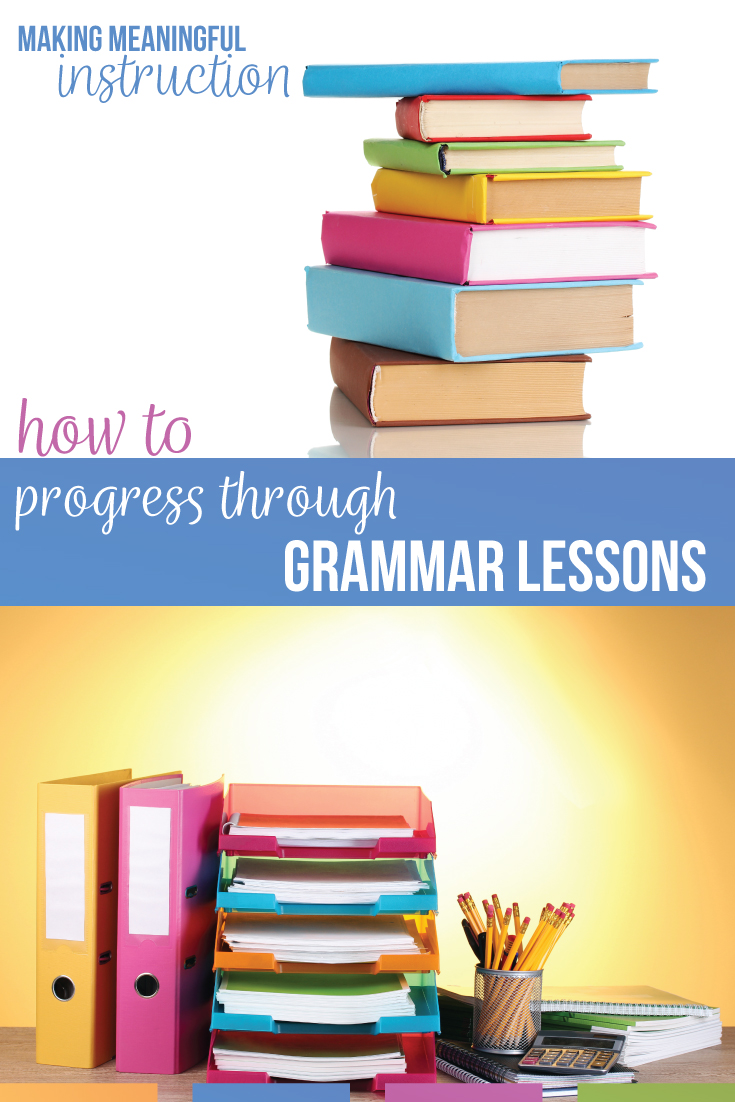
When I build a grammar lesson plan, I plan for 20 minutes of class time. The following class period, we often review the idea, apply it to our writing, or analyze a piece of literature or nonfiction with our grammar concept.
You can build a grammar lesson plan that engages students and meets standards. Hopefully, this outline provides the basics for your grammar activities. I treat grammar like I do public speaking, reading, or writing… as an essential part of my language arts classroom. Soon your students will too.
Are you looking for a supportive community of teachers who work on sequencing grammar and discuss how to build a grammar lesson? Join my private Facebook group, Grammar Gurus for support.


